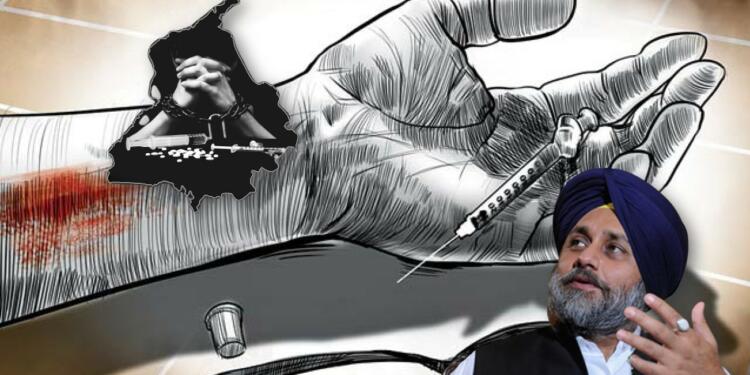Punjab, a crucial state of the nation that shares a 533-kilometre border with Pakistan, is going into polls. Whataboutery is a common phenomenon before elections. But doing it without caring about the interest of people can prove to be costlier.
Also Read: Four reasons why AAP is not winning Punjab
Shiromani Akali Dal’s Sukhbir Singh Badal, in an interview with The Print, held the media responsible for painting a tainted image of Punjab. Badal asked why there is no ‘Udta Bombay’ and ‘Udta Bollywood’. He claimed, “no chittas (adulterated form of heroin) can be found in Punjab”.
Badal on Drug Issue
Election campaigns have been carried out in full swing in Punjab. In between such a campaign, the SAD chief spoke to The Print and made some factually incorrect statements that were not even questioned by the journalist.
During the interview, on a question about the image of the border state, Sukhbir Badal claimed that the wrong image of Punjab has been painted by the media over time. Badal claimed that drug abuse is not a reality of the border state. Punjab’s image has been tainted by the media by writing about the drug issue. Badal said, “Punjab has got no chittas. Have you found any drug addict lying on the road?”. Recalling the film Udta Punjab that raised the issue of drug abuse in Punjab, Badal questioned, “does anybody talk about Udta Bollywood or Udta Bombay?”
How Badal is factually incorrect?
Badal while making these statements completely forgot about the hardships the families are facing due to the easy availability of drugs. Lakhs of people especially teenagers enrol themselves for deaddiction every year. Let’s see how Badal’s denial is factually incorrect.
Punjab’s youth have been trapped in drugs since the 1990s. Generation after generation the families of Punjab have witnessed devastation due to drugs. Drugs have wreaked havoc on the border state.
On the very first day of this year, the newspapers in Punjab reported deaths related to drug abuse from Bathinda. According to media reports, every month two to three drug overdose deaths are reported from the border state.
The National Crime Records Bureau says that 19% of the total cases registered under Narcotic Drugs & Psychotropic Substances (NDPS), Act 1985 were from the border state. According to the NCRB data of 2018, 11,654 cases were registered in Punjab under this act. This makes it the second-highest state to register such cases in the whole country.
A report was published by the Ministry of Social Justice and Empowerment named Magnitude of Substance Abuse in India report was published in 2019. This report was published by the Ministry in collaboration with the National Drug Dependence Treatment Centre (AIIMS). This report says that around 720,000 people needed help in Punjab in 2017-18. Amongst this, 5,70,000 needed help for Cannabis-related problems whereas around 2,00,000 for addiction to pharmaceutical sedatives.
Another survey claimed that there exist 2,32,000 drug dependents in the state of Punjab. The Punjab Opioid Dependence Survey (PODS), commissioned by the Union government was conducted in 2015. This report claimed that the consumption of opioids in India is three times the world. In which Punjab tops the list. According to Dr Atul Ambedkar, the principal investigator of PODS, the consumption rate in the border state is more than double.
| National Average | Punjab | |
| Alcohol | 14.6% | 28.5% |
| Cannabis | 2.8% | 12.5% |
| Opioid | 2.1% | 9.7% |
During the lockdown, around 1,29,000 individuals enrolled themselves in 341 Government as well as private de-addiction centres across Punjab in 2019.
United Nations Office on Drugs and Crime (UNODC) Believes that Punjab is a destination as well as a transit point for drug smuggling from Afghanistan. The main reason cited by the UNODC for this is that Punjab is a border state that shares a border of 533 kilometres with Pakistan.
The Drug Nexus of Punjab
The people of Punjab are actually fighting a battle. A battle in which they are alone. The only support they have is from some activists and NGOs. Many people who have actually died from drug overdose had returned from de-addiction centres.
There are three questions. First, why are drugs so easily available? Second, what is the state and the police doing to curb the drug nexus and nab the people involved? Third and most important, is anyone actually serious about eradicating the drug menace?
Not only the people of Punjab but the whole Nation is waiting for these answers. Drug abuse has become just a political jumla. Every party contesting elections in the border state has made several promises to curb the drug menace if they come to power. Unfortunately, the people of Punjab have been suffering for two decades, and no one knows when their sufferings will come to an end. At last, No problem can be solved through denial.


































